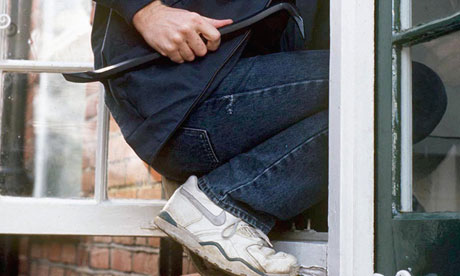There has been a surprise 8% drop in crime across England and Wales, according to official figures, suggesting the long-term decline in crime since the mid-1990s has resumed.
The latest quarterly crime figures also show a 10% fall in the murder rate to 551 homicides in the 12 months to September 2012, 56 fewer than the previous year. This is the lowest murder rate since 1978.
The latest figures for the 12 months to September show surprise falls on both measures of crime, with the crime survey of England and Wales down 8% and police recorded crime figures showing a 7% drop. The falls were driven by drops in vandalism, burglary and vehicle-related thefts.
One sub-category that showed a 6% rise was personal thefts, such as pickpocketing and mobile phone snatches. There was also a rise in thefts from sheds, garages and gardens.
Official statisticians said the 8% fall recorded by the latest crime survey followed a 6% fall in the previous year and was evidence that the long-term downward trend had resumed.
The crime survey for England and Wales, which asks 40,000 people about their experience of crime, estimates there were 8.9m crimes committed against households and resident adults. It estimates that a further 800,000 offences were committed against children aged 10 to 15. These levels of crime are the lowest since the crime survey began in 1981.
Mark Bangs, the Office for National Statistics deputy head of crime, said: "Looking at the long-term picture, after levels of crime peaked in the mid-90s, there were then substantial falls through to the 2004-05 survey, after which crime continued to fall at a slower rate. Since 2009-10 levels of crime have been fairly flat.
"However, the latest estimates show an 8% fall compared with the previous year, which follows on from a 6% decrease reported in the last quarterly bulletin."
He said that, taken together, the 14% fall reported in two consecutive quarters "may be evidence of an emerging downward trend in crime measured by the survey". The statisticians are still, however, slightly cautious about declaring it a definite trend, saying the figures cover two overlapping time periods.
Violent crime continued to fall, with a 5% drop on the police recorded crime figures. The 10% drop in the murder rate was fuelled by a 17% drop in gun crime and an 11% fall in knife crime.
The police figures also show a 5% fall in the total number of sexual offences. The most serious sexual offences, which include rape and serious sexual assault, fell by 6% to 44,394 offences. This, however, conceals a rise in rape to 14,767 attacks on women in 2011-12. The number of rapes reported to the police by women has risen from 11,664 since 2007-08.
The latest figures also contain an estimate of crime levels involving business for the first time since 2002. The results show that there were 9.2m offences against businesses, with the majority involving thefts in the retail and wholesale sector.
The quarterly figures for antisocial behaviour confirm the overall downward trend in crime, with 2.4mincidents recorded by the police in 2011-12.
A separate analysis of the variation in crime trends published on Thursday by the ONS shows a 41% drop in crime between 2002-03 and 2011-12 for police recorded crime figures, compared with a 26% drop in the crime survey results over the same period. The difference is even more marked in the most recent five years, with the police figures recording a 33% drop since 2006-07 compared with a 17% drop in the crime survey estimate over the same period.
Statisticians say one explanation for the difference may have been pressure on the police to downgrade incidents in the face of a targets culture. The study says the police figures may overstate the actual long-term fall in crime, especially since 2006-07.
The ONS statisticians say they can't be certain what lies behind this difference but that it could point to a gradual erosion of police compliance with national crime recording standards. Alternatively, it may be the result of "a natural correction" to an over-recording of offences by the police in the early years of the new crime reporting standards. The statisticians say that in the absence of independent audits since 2006-07 it is not possible to give an definitive answer.
Jeremy Browne, the crime prevention minister, said the figures showed crime was now at its lowest level since the crime survey began in 1981: "Police reform is working. We have swept away central targets, reduced bureaucracy and these figures show forces are rising to the challenge of doing more with less. Many have achieved significant reductions in crime with reduced budgets."
But Labour's policing spokesman, David Hanson, said while the continued crime reductions were welcome, the increases in personal thefts and retail crime were a warning sign: "This is perhaps why the Office for National Statistics has begun to express concern that apparent reductions in police recorded crime may be exaggerated. The home secretary should examine urgently whether, as the ONS suggests, the cuts to police budgets mark a return to fewer crimes being recorded by the police."

No comments:
Post a Comment